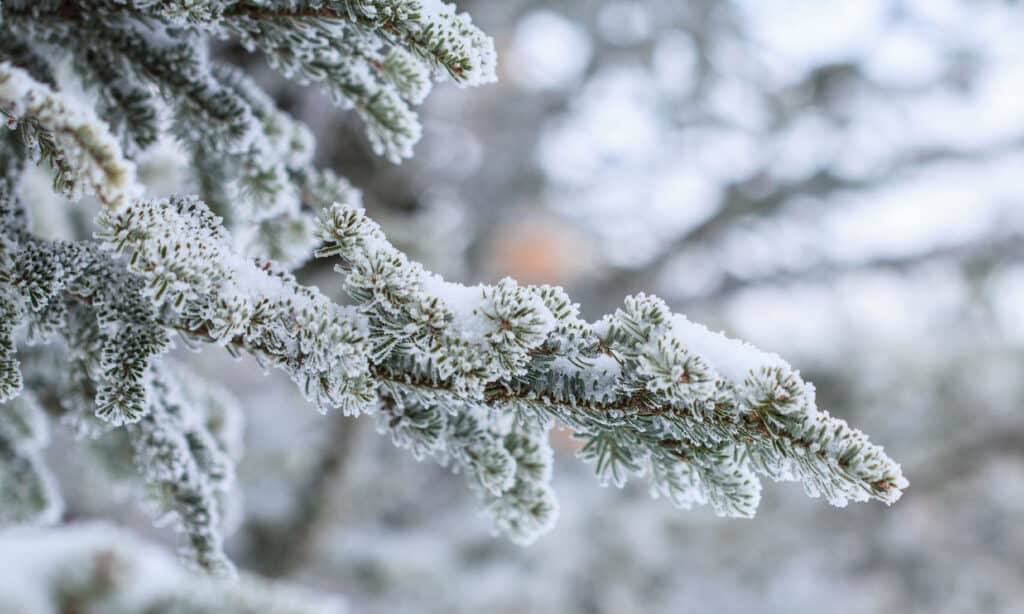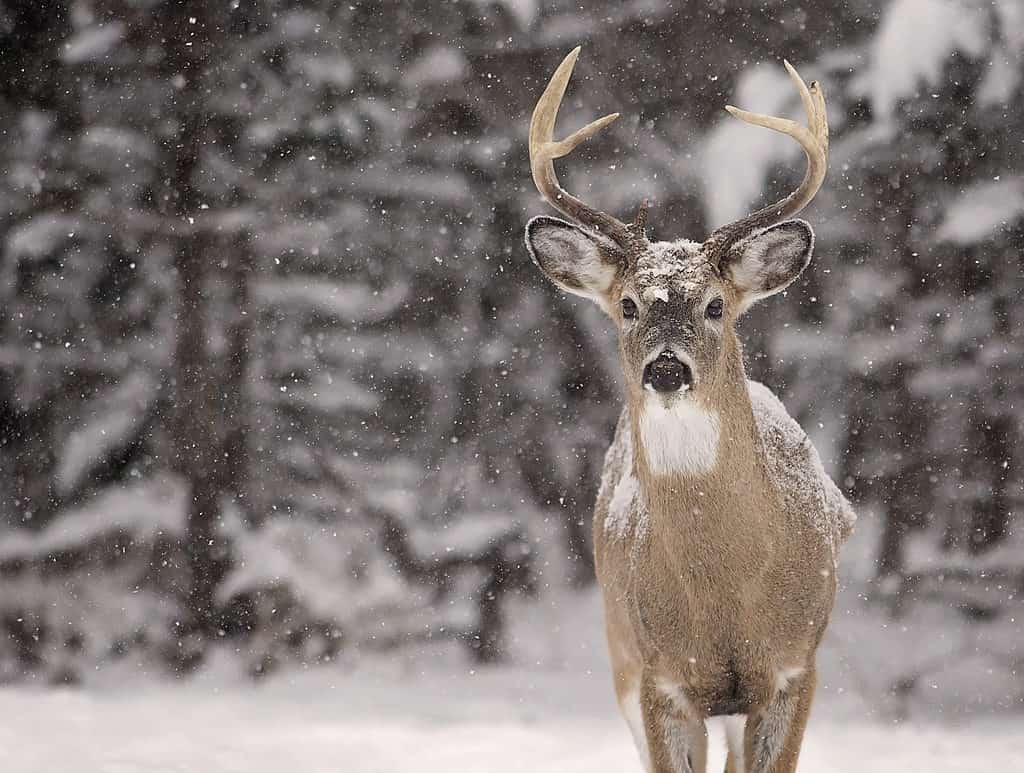Key Facts
- Maryland experiences between 30-100 inches of snow during winter.
- The first snow of the year normally falls in December, although it may also fall in November.
- The earliest snow that has ever fallen was October 10, 1979.
Only a stone’s throw away from our nation’s capital, you may be wondering when the first snow in Maryland falls. A pleasant mix of forests and oceans, Maryland has a lot to offer the average outdoor enthusiast and traveler. But what can you expect out of visiting Maryland during the wintertime season and how much does it truly snow in this state?
In this article, we will address everything you need to know about the earliest and latest first snow dates in the state of Maryland. We will even go over when snow typically falls on average and how much snow Maryland usually gets during the months of November, December, and January.
Then we’ll throw in information about winter temperature and what the wildlife animals do in winter. Let’s get started and talk all about winter in Maryland now!
Understanding First Snow in Maryland

Generally speaking, Maryland typically sees its first snow during the month of December, but occasionally November will herald the beginning of winter.
©Konstantin L/Shutterstock.com
| Snowfall Classification | Maryland Snow Facts |
|---|---|
| Earliest First Snowfall | October 10 (1979) |
| Latest First Snowfall | December 28 (1993) |
| Average Temperature | 25-50 degrees Fahrenheit |
| Largest Seasonal Snowfall | 310 inches (2010) |
| Smallest Seasonal Snowfall | Less than one inch (1950) |
| Places to Enjoy the Snow | Savage River State Forest, Baltimore, Garrett County |
Resting alongside the Chesapeake Bay, Maryland doesn’t experience as much snow as other locations in the United States. However, the majority of the state still sees above-average amounts of snow during the wintertime, averaging anywhere from 30 to 100 inches annually.
Additionally, Maryland experiences an average seasonal snowfall of 20.6 inches that varies from 10 inches on the lower Eastern Shore to 110 inches in Garrett County, and the highest recorded snowfall in a single winter was 262.5 inches at Keysers Ridge in Garrett County during the winter of 2009-10.
While this certainly doesn’t seem like much compared to states like New Hampshire and Utah, Maryland still gets cold and snowy during December and January in particular! In fact, the westernmost portions of Maryland frequently see an average of 100-200 inches each and every year.
But when was the earliest date that Maryland ever saw snow, and how cold is it there on average? Let’s take a closer look at the figures.
Earliest and Latest Snowfalls in Maryland

Resting alongside the Chesapeake Bay, Maryland doesn’t experience as much snow as other locations in the United States.
©iStock.com/DonLand
Generally speaking, Maryland typically sees its first snow during the month of December, but occasionally November will herald the beginning of winter. However, October 10th, 1979 was the first ever snow for that winter season, and it is the earliest date on record for the first snow in Maryland. When you consider the fact that Maryland typically doesn’t get snow until 2 months later, October 10th is a very early date!
In direct contrast to this date, December 28th, 1993 has been recorded as the latest first snowfall date in Maryland. This may still be considered an average first snowfall date for much of the state, but precipitation typically occurs much earlier on average. However, temperatures and overall precipitation in the state definitely effects when the first snowfall occurs. This is especially true when abnormal weather conditions occur – let’s talk about those now.
Largest and Smallest Snowfalls in Maryland

December 28th, 1993 has been recorded as the latest first snowfall date in Maryland.
©Gary C. Tognoni/Shutterstock.com
Very few things can prepare a state for excess snowfall and winter weather conditions. However, in the 2010 winter season, much of the East Coast was slammed with what is now referred to as a snowmageddon.
Some portions of Maryland saw 77 inches during the 2010 season, far exceeding their average. Many people report that this record-breaking snowstorm was the most snow they have ever seen in their entire lives, particularly people who have lived in Maryland for decades.
Speaking of these extremes, the 2010 snowstorm brought over 300 inches of snow to annual totals in western counties in Maryland, particularly Garrett County and locations near the Great Lakes. In direct contrast to this, the year 1950 brought less than a single inch of snow to the state of Maryland. When you consider that 2010 had more snow than necessary, perhaps the year 1950 was a more welcome winter by comparison!
Winter Temperatures in Maryland
For the most part, the average temperatures in Maryland don’t change very much from north to south within the state. However, as you move away from the Chesapeake Bay and the Maryland coastline, you will notice that temperatures do indeed warm up, particularly in the wintertime. When comparing Baltimore with other, more northern locations within the state, temperatures fluctuate by an average of 5 to 10 degrees.
For example, northern Maryland locations experience winter temperatures of roughly 25 to 35 degrees Fahrenheit. The coastline and towns near Baltimore experience average temperatures of 30 to 50 degrees Fahrenheit, depending. The locations nearest the water have the most protection from cold climates and winter weather, but this still doesn’t prevent icy and frigid conditions!
Additionally, Maryland was hit hard by Hurricane Sandy. Maryland reported a total damage estimate of $42.6 million. 11 fatalities were caused by the Hurricane, making it the most lethal tropical cyclone to impact the state. Further, the heavy, wet snow caused by Hurricane Sandy led to the collapse of business roofs.
Winter Wildlife in Maryland

Maryland saw 77 inches total during the 2010 season, far exceeding their average.
©iStock.com/DawnKey
Whether you plan on skiing or hiking in Maryland during the wintertime, this state has plenty to offer in terms of its wildlife. If you are an avid outdoor enthusiast, here are some of the animals that you might see while traversing the winter terrain found throughout Maryland:
- Badgers: The North American badger features short, stubby legs, a muscular body, a short neck, and elongated claws. The mammals are nocturnal, and some are social while others are loners. Badgers are animals that are famous for their ferocity. If a female adult badger has babies to protect, then she’ll guard them aggressively. Badgers are omnivores that prey mainly on smaller animals like ground squirrels and moles. They are actually a major predator of snakes and will even go after rattlesnakes.
- Chipmunks: This rodent is the tiniest member of the squirrel family! Chipmunks are small mammals that live in burrows, fallen logs, or holes under houses. This rodent uses its delicate claws to dig holes and climb trees. They also have pouches in their cheeks that they fill up with nuts, fruit, seeds, and more. These rodents are solitary animals and will go into hibernation in really cold areas.
- Deer: The deer is a kind of evolutionary success story. It is proliferated across the globe and evolved many adaptations. Its antlers are some of the most notable characteristics, used for defense and sexual signaling. These are shed and then grown back every year after the end of the mating season. Deer are social animals. They usually congregate into small groups for feeding, mating, and protection. But when startled, it can spring into action with its remarkable speed, agility, and finesse.
- Opossums: Opossums hold the distinction of being the only marsupial that lives in the United States and Canada! A fully grown opossum is roughly the size of a housecat, with a pointy nose and a rat-like tail. Contrary to popular belief, opossums do not hang upside down from trees by their tails like bats. Solitary and nomadic in general, they are primarily active at night, when they scavenge for food and engage in most other activities.
- Rabbits: These fluffy creatures aren’t the only ones eating food out of your garden, even if they are the first to be blamed! Rabbits have actually been domesticated since Roman times, and possibly even before that. herbivores eat a diet of mostly green foods, but they are also opportunistic feeders that will eat seeds, fruit, and bark. They live in large groups in underground tunnels and they really do breed like rabbits. The female is ready to breed almost any time, and she’ll have a litter of babies about 30 days after breeding.
- Hawks: You will come across a wide range of birds of prey in the dense forests, marshes, and prairies of Maryland. Rough-legged hawks are large and commonly sighted during winter. Red-shouldered hawks are medium-sized raptors found throughout the year. Check out the rest from our list of 8 hawks in Maryland.
- Beavers: This semi-aquatic rodent can alter its surrounding landscape in order to shield itself from dangerous predators. The beaver has a stout body, strong neck, oversized head, short and rounded ears, dexterous hands, webbed feet, and a flat tail. The beaver is the second-largest rodent in the world and is known as a faithful partner that will form long-term monogamous relationships with a single mate. Beavers have a life expectancy of about 10 to 20 years in the wild.
- Woodpeckers: Woodpeckers are birds that live in nearly every region of the world. They have a unique feet setup, called zygodactyl, with the first and fourth toes facing backward, and the second and third facing forward, so they can grip tree trunks more efficiently. Their tongue is also unique: It is typically twice the length of its beak, able to reach into crevices for insects, and wraps around the back of its head between the tissue and the bone, acting as a shock absorber when the bird is drumming.

Antlers are some of the most notable characteristics of deer. These are shed and then grown back every year after the end of the mating season.
©iStock.com/Lynn_Bystrom
Highlighting the Western Part of Maryland

Greenbrier Lake is located within the Appalachian Mountains in Western Maryland and is known for massive-sized bass swimming in its waters
©Jon Bilous/Shutterstock.com
Western Maryland is a region that encompasses Allegany, Garrett, and Washington counties, and occasionally includes Frederick County and Carroll County. These counties are situated in the westernmost part of Maryland, bordering Pennsylvania, West Virginia, and Virginia.
The region is known for its picturesque mountain ranges, deep valleys, and rolling hills. Western Maryland is also home to several state parks and national forests. Maryland has ten of its twenty-four local jurisdictions serving as sites for national parks, which offer tourists and locals easy access to historic residences, Civil War battlegrounds, mountain paths, and views of the Atlantic Ocean.
Although Maryland generally has mild weather throughout the year, with temperature variations among different regions of the state, the western counties tend to have colder weather and more snow, whereas the Eastern Shore and Southern Maryland tend to remain cool, and fluctuations in temperature are attributed to the elevation and coastal areas.
The photo featured at the top of this post is © eyerazor/Shutterstock.com
Sources
- Thursday's snow is Baltimore's earliest in 22 years, and heaviest for November since at least 1989, Available here: https://www.baltimoresun.com/weather/bs-md-earliest-snow-20181115-story.html
Thank you for reading! Have some feedback for us? Contact the AZ Animals editorial team.






